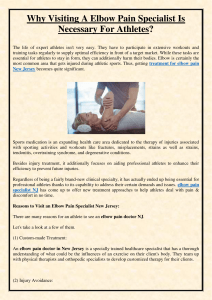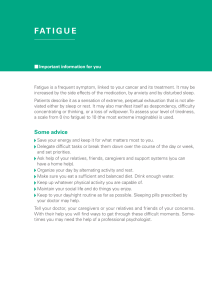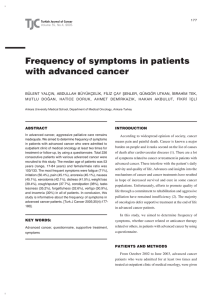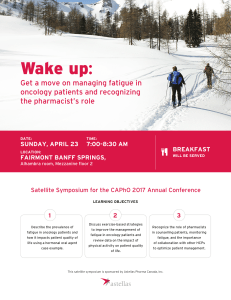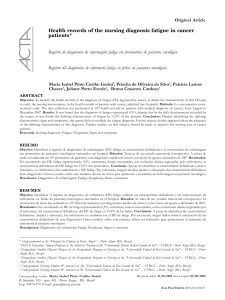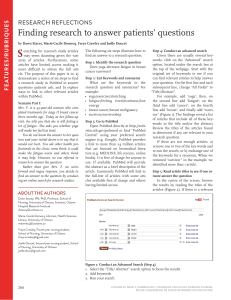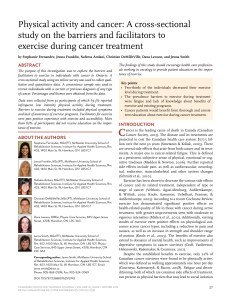http://bjsm.bmj.com/content/38/1/42.full.pdf
publicité
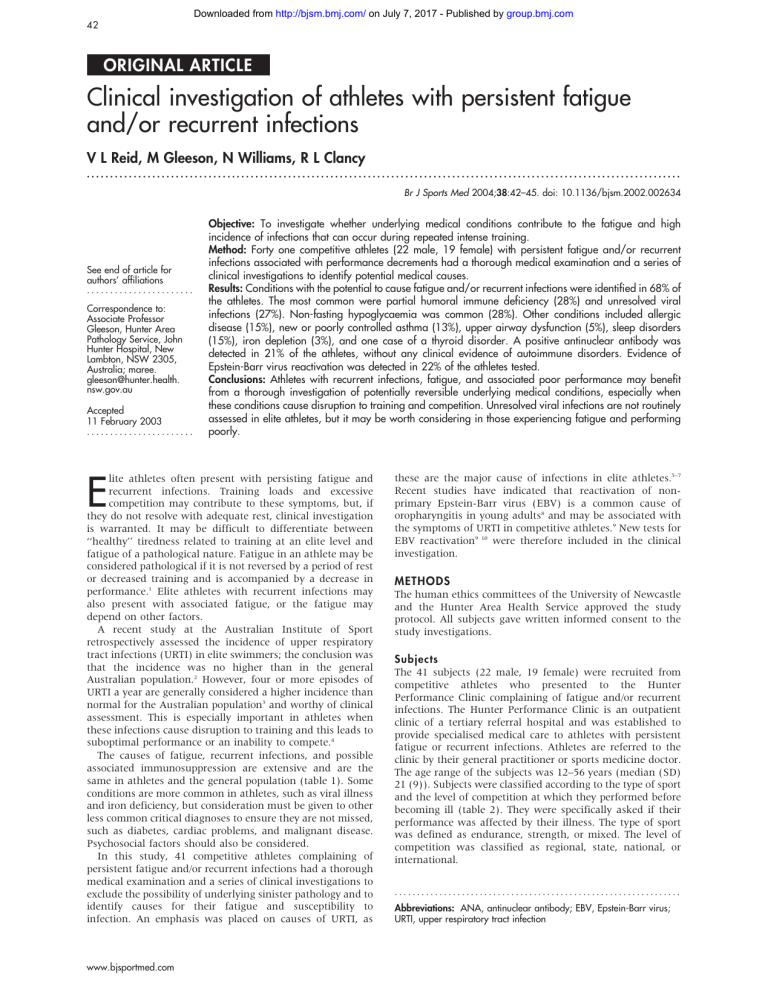
Downloaded from http://bjsm.bmj.com/ on July 7, 2017 - Published by group.bmj.com 42 ORIGINAL ARTICLE Clinical investigation of athletes with persistent fatigue and/or recurrent infections V L Reid, M Gleeson, N Williams, R L Clancy ............................................................................................................................... Br J Sports Med 2004;38:42–45. doi: 10.1136/bjsm.2002.002634 See end of article for authors’ affiliations ....................... Correspondence to: Associate Professor Gleeson, Hunter Area Pathology Service, John Hunter Hospital, New Lambton, NSW 2305, Australia; maree. [email protected]. nsw.gov.au Accepted 11 February 2003 ....................... E Objective: To investigate whether underlying medical conditions contribute to the fatigue and high incidence of infections that can occur during repeated intense training. Method: Forty one competitive athletes (22 male, 19 female) with persistent fatigue and/or recurrent infections associated with performance decrements had a thorough medical examination and a series of clinical investigations to identify potential medical causes. Results: Conditions with the potential to cause fatigue and/or recurrent infections were identified in 68% of the athletes. The most common were partial humoral immune deficiency (28%) and unresolved viral infections (27%). Non-fasting hypoglycaemia was common (28%). Other conditions included allergic disease (15%), new or poorly controlled asthma (13%), upper airway dysfunction (5%), sleep disorders (15%), iron depletion (3%), and one case of a thyroid disorder. A positive antinuclear antibody was detected in 21% of the athletes, without any clinical evidence of autoimmune disorders. Evidence of Epstein-Barr virus reactivation was detected in 22% of the athletes tested. Conclusions: Athletes with recurrent infections, fatigue, and associated poor performance may benefit from a thorough investigation of potentially reversible underlying medical conditions, especially when these conditions cause disruption to training and competition. Unresolved viral infections are not routinely assessed in elite athletes, but it may be worth considering in those experiencing fatigue and performing poorly. lite athletes often present with persisting fatigue and recurrent infections. Training loads and excessive competition may contribute to these symptoms, but, if they do not resolve with adequate rest, clinical investigation is warranted. It may be difficult to differentiate between ‘‘healthy’’ tiredness related to training at an elite level and fatigue of a pathological nature. Fatigue in an athlete may be considered pathological if it is not reversed by a period of rest or decreased training and is accompanied by a decrease in performance.1 Elite athletes with recurrent infections may also present with associated fatigue, or the fatigue may depend on other factors. A recent study at the Australian Institute of Sport retrospectively assessed the incidence of upper respiratory tract infections (URTI) in elite swimmers; the conclusion was that the incidence was no higher than in the general Australian population.2 However, four or more episodes of URTI a year are generally considered a higher incidence than normal for the Australian population3 and worthy of clinical assessment. This is especially important in athletes when these infections cause disruption to training and this leads to suboptimal performance or an inability to compete.4 The causes of fatigue, recurrent infections, and possible associated immunosuppression are extensive and are the same in athletes and the general population (table 1). Some conditions are more common in athletes, such as viral illness and iron deficiency, but consideration must be given to other less common critical diagnoses to ensure they are not missed, such as diabetes, cardiac problems, and malignant disease. Psychosocial factors should also be considered. In this study, 41 competitive athletes complaining of persistent fatigue and/or recurrent infections had a thorough medical examination and a series of clinical investigations to exclude the possibility of underlying sinister pathology and to identify causes for their fatigue and susceptibility to infection. An emphasis was placed on causes of URTI, as www.bjsportmed.com these are the major cause of infections in elite athletes.5–7 Recent studies have indicated that reactivation of nonprimary Epstein-Barr virus (EBV) is a common cause of oropharyngitis in young adults8 and may be associated with the symptoms of URTI in competitive athletes.9 New tests for EBV reactivation9 10 were therefore included in the clinical investigation. METHODS The human ethics committees of the University of Newcastle and the Hunter Area Health Service approved the study protocol. All subjects gave written informed consent to the study investigations. Subjects The 41 subjects (22 male, 19 female) were recruited from competitive athletes who presented to the Hunter Performance Clinic complaining of fatigue and/or recurrent infections. The Hunter Performance Clinic is an outpatient clinic of a tertiary referral hospital and was established to provide specialised medical care to athletes with persistent fatigue or recurrent infections. Athletes are referred to the clinic by their general practitioner or sports medicine doctor. The age range of the subjects was 12–56 years (median (SD) 21 (9)). Subjects were classified according to the type of sport and the level of competition at which they performed before becoming ill (table 2). They were specifically asked if their performance was affected by their illness. The type of sport was defined as endurance, strength, or mixed. The level of competition was classified as regional, state, national, or international. ................................................................ Abbreviations: ANA, antinuclear antibody; EBV, Epstein-Barr virus; URTI, upper respiratory tract infection Downloaded from http://bjsm.bmj.com/ on July 7, 2017 - Published by group.bmj.com Fatigue and infections in athletes 43 Table 1 Clinical conditions associated with fatigue or recurrent infections Common conditions Less common conditions Immunodeficiency Acute or unresolved infections Allergic disease Autoimmune disease Asthma Airway dysfunction Anaemia Nutritional deficiency Depression Psychological factors Sleep disorders Diabetes mellitis Thyroid disease Cardiovascular disease Muscle dysfunction Renal disorders Liver failure Malignancy Fatigue level The degree of fatigue was assessed by a subjective visual analogue rating scale. Subjects were asked to indicate their degree of tiredness at rest and after exercise on a scale of 1 (profound, could not train) to 5 (absent, no fatigue). The duration of symptoms of fatigue was also recorded. Infectious episodes Twenty two athletes (54%) presented to the clinic with a history of recurrent URTI. Fifteen of these (68%) also had associated fatigue. The number of URTIs in the previous 12 months was recorded. Confirmation of the incidence and nature of the URTIs was obtained from medical records where available. Medical records were not available for four subjects, and the incidence was by subject recall, with extensive questioning to confirm the accuracy of the recall. Clinical investigations Subjects provided an extensive medical history and had a thorough medical examination to establish if there were any underlying medical conditions. Saliva and blood samples were referred to the Hunter Area Pathology Service. Reference ranges appropriate for elite athletes were used to assess pathology test results.11 Pathology investigations included a full blood count, erythrocyte sedimentation rate, iron studies (including total iron, total iron binding capacity, ferritin), and vitamin B12 and folate measurements. A full biochemical profile included glucose concentration, creatine kinase activity, and renal, liver and thyroid function tests. A screen of infectious disease included serology for hepatitis A, B, and C, toxoplasmosis, cytomegalovirus, EBV, and Ross River virus. EBV reactivation was also assessed by detection of EBV DNA in saliva.9 Humoral immune status was assessed by measuring serum immunoglobulins, including IgG subclasses, and salivary immunoglobulins. Cellular immune status was not assessed. An antinuclear antibody (ANA) test was performed as an autoimmune screen, and followed up with other specific autoimmune serology if indicated, including extractable nuclear antigen, double stranded DNA, and complement levels. Allergy was assessed clinically and by measurement of total IgE levels and IgE specific aeroallergens to animal-epithelial mix, pollen mix, house dust mix, and mould mix. Diagnostic investigations were also performed for sleep disorders, muscle dysfunction, cardiovascular disease, and respiratory dysfunction if clinically indicated. Patients were referred to a psychologist or dietician for assessment and advice if required. Appropriate specialist referral was organised where clinically indicated for subjects with evidence of autoimmunity or abnormal cardiac or respiratory function tests. Table 2 Primary competitive sport of the athletes and level of competition before illness Primary sport No of athletes Swimming Running Ironman Rugby league Cycling Hockey Triathlon Basketball Rowing Wake boarding Slalom skiing 15 7 6 3 2 2 2 1 1 1 1 Level of competition Regional State National International 1 3 3 1 4 3 2 1 2 1 10 1 1 1 1 2 1 1 1 1 RESULTS Most of the subjects (35/41) competed in endurance sports; none competed in a solely strength sport. The remainder competed in mixed endurance/strength sports (table 2). All were competing at the level of regional competition or above at the time of recruitment into the study or immediately before the decline in their clinical condition. Fatigue Fatigue was reported in 30/35 (86%) of the athletes who were assessed on a fatigue scale. Three of these complained of severe fatigue. The mean degree of fatigue experienced was 3 on the subjective rating scale of 1–5. The period of fatigue experienced by subjects before presenting to the clinic was 0.5–84 months (median 10). Infections The number of infections during the previous 12 months ranged from none to 28. In the 22/41 athletes experiencing recurrent infections (55%), the mean number of episodes over the previous year was 13 (range 4–28). Most infections were described as URTI. Three of the athletes had a history of recurrent sinusitis and two of recent pneumonia that had been successfully treated by their general practitioner. One subject had recurrent onychomycosis of fungal origin. Fifteen of the 22 subjects (68%) who reported infections had associated fatigue; the remaining seven had no associated fatigue. Clinical investigations Evidence of at least one organic condition with the potential to cause fatigue and/or recurrent infections was identified in Table 3 Conditions with the potential to cause fatigue and/or recurrent infection identified in athletes Condition identified No of athletes Partial humoral immune deficiency Hypoglycaemia Primary or unresolved infections EBV reactivation Allergic disease Sleep disorder Poorly controlled or undiagnosed asthma Newly diagnosed exercise induced asthma Upper airway dysfunction Thyroid disorder Low serum ferritin 11/40 (28) 10/36 (28) 11/41 (27) 8/37 (22) 6/41 (15) 6/40 (15) 3/40 (8) 3/40 (8) 2/40 (5) 1/40 (3) 1/40 (3) Values in parentheses are percentage of athletes studied. EBV, Epstein-Barr virus. www.bjsportmed.com Downloaded from http://bjsm.bmj.com/ on July 7, 2017 - Published by group.bmj.com 44 Reid, Gleeson, Williams, et al Table 4 Number of athletes with multiple medical conditions identified with the potential to cause fatigue and/or recurrent infection No of conditions identified No of athletes 0 1 2 3 4 5 13 (32) 11 (27) 11 (27) 3 (7) 2 (5) 1 (2) Values in parentheses are percentage of athletes studied (n = 41). 28/41 (68%) subjects, with some showing evidence of more than one condition (table 3). There was no fixed pattern of medical conditions identified for athletes with evidence of more than one condition (table 4). There was no identifiable cause for the fatigue or recurrent infections in 13/41 athletes (32%). The most common condition identified in this group was partial humoral immune deficiency (11/40, 28%). Most of these athletes (10/11) had an IgG3 subclass deficiency. One athlete had a partial serum IgA deficiency. Another commonly identified organic condition was recent or unresolved viral infection (11/41, 27%). Evidence of IgM seropositivity was found for cytomegalovirus (five cases), EBV (three cases), Ross River virus (one case), toxoplasmosis (one case), and mycoplasma (one case). Eight of the 37 subjects tested (22%) were found to have evidence of EBV viral shedding in their saliva at the time of investigation, indicating EBV reactivation. Low non-fasting serum glucose levels were found in 10/36 (28%) athletes at the time of assessment. Blood tests were performed randomly without taking into consideration recent exercise or glucose intake. Thyroid dysfunction was noted in one female athlete, and this was not associated with amenorrhoea, which is a common cause of thyroid disorders in female athletes.12 The thyroid dysfunction consisted of slightly raised thyroid stimulating hormone and low thyroxine with high to normal tri-iodothyronine, in conjunction with a family history of thyroid disease. One athlete had a low serum ferritin concentration suggestive of iron deficiency anaemia. Evidence of an allergic disease was found in six athletes (15%). All six had symptoms of allergic rhinitis, and four also had asthma. Three had raised total IgE concentrations at the time of testing, and all six had raised concentrations of IgE specific aeroallergens (house dust mite, 6/6; pollen, 4/6; animal/epithelial mix, 3/6; mould, 4/6). Skin prick testing was not performed. Positive ANAs were detected in eight of 39 athletes (21%), with titres of 1:40 (1), 1:80 (4), 1:160 (1), and 1:320 (2). The ANA patterns included speckled, homogeneous, atypical speckled, and nucleolar. Seven of these eight ANA positive subjects (four female, four male) were adolescents aged 14– 20 years. Clinical investigation by a specialist immunologist and further autoimmune serology testing (double stranded DNA, extractable nuclear antigen, and complement concentrations) failed to identify any further evidence of autoimmune disease at the time of testing. Six athletes (15%) reported a history of inadequate sleep. Four of these were shift workers. Nine athletes (23%) gave a history consistent with respiratory disease. Three were well controlled asthmatics and required no further advice or treatment. Respiratory function testing before and after exercise led to a new diagnosis of exercise induced asthma in three athletes, two of whom were known asthmatics. www.bjsportmed.com Upper airway dysfunction was found in two of the athletes thought previously to have asthma. Specialist investigations of identified psychological factors or nutritional status were not required in this cohort. DISCUSSION There was clinical evidence of at least one or more medical conditions with the potential to cause fatigue or contribute to infection risk in 68% of the athletes. They were multifactorial, with no consistent pattern for the overall group. Evidence of chronic unresolved infection or humoral immune deficiencies, which have the potential to leave a subject at risk of infection, were the most common findings. The most important outcome of this study was that all identified conditions were treatable. Previous studies have suggested that intense exercise is associated with immune suppression, which leaves an athlete susceptible to infections.6 13 14 These infections in turn may contribute to fatigue and cause poor performance or an inability to train at an effective level.15 16 A retrospective study of the incidence of URTI in elite swimmers at the Australian Institute of Sport2 found an incidence of 2.7 episodes a year, similar to that in the general Australian population.3 However, the number of athletes in our study with episodes of recurrent URTI (55%) exceeded the Australian average, indicating that infections are an important cause of morbidity in elite athletes. Only three subjects (8%) reported no decline in performance level, suggesting an association between recurrent infections and performance decrement. This lends further support to previous studies showing an association between poor performance and URTI before competition.16 The most common finding was humoral immune deficiencies, particularly IgG3 deficiency. This subclass deficiency is associated with susceptibility to viral URTIs17 and may explain the finding of unresolved viral infections in an appreciable number of these athletes (27%). Viral illness as a cause of long term fatigue often goes undetected unless specific investigations for IgM seropositivity are requested. In addition, eight of 37 athletes tested (22%) were actively secreting EBV into their saliva at the time of testing. The detection of EBV shedding suggests immune dysregulation of the cytotoxic T cells18 and may contribute to the symptoms of URTI experienced by these athletes. EBV reactivation has recently been established in swimmers engaged in intensive training, and is thought to result from exercise induced alterations in the immune mechanisms responsible for controlling viral reactivation.9 The finding of hypoglycaemia in 10 athletes was unexpected, as they were non-fasting and generally well informed of the need to replenish glucose stores after intense exercise. Hypoglycaemia per se is known to have detrimental effects on the immune system; it has the potential to contribute to fatigue through neuroendocrine dysregulation and may have associated increased risks of infections.19 It is known that consuming carbohydrate during exercise attenuates rises in stress hormones, such as cortisol, and appears to limit the degree of exercise induced immunosuppression, at least for non-fatiguing bouts of exercise.19 Counselling athletes on the use of carbohydrates in the recovery period after exercise has the potential to correct the hypoglycaemia. The finding of ANAs in the serum of 21% of the athletes was surprising, considering the young age of most of them. The seroprevalence of ANAs in the normal Australian population is 5–10% and increases with age.20 Two other studies have reported on the incidence of ANA positivity in athletes.21 22 A study of a group of adolescent athletes showed no increase in the incidence of ANAs,22 but an increased seroprevalence was reported in a group of weight lifters.21 The cause of the low titre ANAs in our study without other Downloaded from http://bjsm.bmj.com/ on July 7, 2017 - Published by group.bmj.com Fatigue and infections in athletes 45 Take home message those athletes who are experiencing persistent fatigue and poor performance. N ..................... N Athletes with recurrent infections and chronic fatigue which affect their training and performance may benefit from a more extensive medical examination and investigations to identify underlying reversible medical conditions. Investigations to identify unresolved viral infections are warranted in these competitive athletes. evidence of autoimmune disease can only be speculated on, but may be related to exercise induced tissue damage unmasking antigens associated with underlying autoimmune diatheses in the face of exercise induced immune dysregulation. As there was no clinical evidence of autoimmune disease, the possibility of contributing to a cause of fatigue could not be evaluated. Asthma, either undiagnosed or poorly managed, can affect the overall wellbeing of athletes. Three new cases of exercise induced asthma were diagnosed, two in known asthmatics, allowing specific advice and treatment to be offered. Two cases of upper airway dysfunction were diagnosed in athletes previously thought to have asthma. Vocal cord dysfunction is the term given to the paradoxical movement of the true or false cords during respiration23 and is an important differential diagnosis to make in athletes experiencing respiratory symptoms, especially those not responding to conventional asthma treatments. Stress management and the intervention of a skilled speech pathologist can be extremely helpful in these athletes. The study highlights the need for comprehensive testing of pulmonary function with exercise in athletes with respiratory symptoms. We assessed how well athletes with identified allergic disease understood their symptoms and the potential causes and how these were currently being managed. Education and advice on specific allergen minimisation or avoidance was discussed. Symptoms of rhinoconjunctivitis were treated with a nasal steroid. CONCLUSIONS The results of this study indicate that medical conditions, in particular unresolved viral infections and parameters of immune suppression, may cause or contribute to fatigue and recurrent infections and subsequent poor performance in competitive athletes. As the conditions are multifactorial, a thorough medical examination and appropriate investigations are paramount in the initial assessment of an athlete presenting with these persisting complaints. The design of management strategies requires a clear understanding of the individual athlete’s underlying medical conditions and expectations. The investigation of chronic unresolved viral infections does not form part of a routine clinical assessment of infection in elite athletes but may be worth considering in Authors’ affiliations V L Reid, M Gleeson, Hunter Area Pathology Service, John Hunter Hospital, New Lambton, NSW, Australia N Williams, R L Clancy, University of Newcastle, Newcastle, NSW, Australia REFERENCES 1 Bruckner P. The tired athlete. Aust Fam Physician 1996;25:1283–8. 2 Fricker PA, Gleeson M, Flanagan A, et al. A clinical snapshot: do elite swimmers experience more upper respiratory illness than non-athletes? Clinical Exercise Physiology 2000;2:155–8. 3 Douglas RM, Muirhead TC. A study of the social, psychological and environmental factors associated with respiratory infections amongst Australians. Adelaide: University of Adelaide, Department of Community Medicine, 1978. 4 Konig D, Grathwohl D, Weinstock C, et al. Upper respiratory tract infection in athletes: influence of lifestyle, type of sport, training effort, and immunostimulant intake. Exerc Immunol Rev 2000;6:102–20. 5 Fricker PA. Infectious problems in athletes: an overview. In: Fields KB, Fricker PA, eds. Medical problems in athletes. Boston, MA: Blackwell Science, 1997:3–5. 6 Peters EM. Exercise, immunology and upper respiratory tract infections. Int J Sport Med 1997;18:S69–77. 7 Robert JA. Viral illnesses and sports performance. Sport Med 1986;3:296–303. 8 Yoda K, Sata T, Kurata T, et al. Oropharyngotonsillitis associated with nonprimary Epstein-Barr virus infection. Arch Otolaryngol Head Neck Surg 2000;126:185–93. 9 Gleeson M, Pyne DB, Austin JP, et al. Epstein-Barr virus reactivation and upper-respiratory illness in elite swimmers. Med Sci Sports Exerc 2002;34:411–17. 10 Gleeson M, Koina C, Clancy RL, et al. Epstein-Barr virus reactivation in elite swimmers. Int J Sports Med 2000;21(suppl 1):83. 11 Australian Institute of Sport. Sports haematology and biochemistry laboratory handbook. Belconnen: Australian Sports Commission, 1999. 12 Boyden TW, Pamenter RW, Stanforth D, et al. Evidence for mild thyroidal impairment in women undergoing endurance training. J Clin Endocrinol Metab 1982;54:53–6. 13 Gleeson M, Pyne DB. Exercise effects on mucosal immunity. Immunol Cell Biol 2000;78:536–44. 14 Nieman DC. Is infection risk linked to exercise workload? Med Sci Sports Exerc 2000;32:S406–11. 15 Pyne DB, Gleeson M, McDonald WA, et al. Training strategies to maintain immunocompetence in athletes. Int J Sports Med 2000;21(suppl 1):S51–60. 16 Pyne D, McDonald W, Gleeson M, et al. Mucosal immunity, respiratory illness, and competitive performance in elite swimmers. Med Sci Sports Exerc 1999;33:348–53. 17 Pan Q, Hammarstrom L. Molecular basis of IgG subclass deficiency. Immunol Rev 2000;178:99–110. 18 Rickinson AB, Moss DJ. Human cytotoxic T lymphocyte responses to EpsteinBarr virus infection. Annu Rev Immunol 1997;15:406–31. 19 Gleeson M, Bishop NC. Modification of immune responses to exercise by carbohydrate, glutamine and anti-oxidant supplements. Immunol Cell Biol 2000;78:554–61. 20 Kavanaugh A, Tomar R, Reveille J, et al. Guidelines for clinical use of the antinuclear antibody test and tests for specific autoantibodies to nuclear antigens. Arch Path Lab Med 2000;124:71–81. 21 Calabrese L, Kleiner S, Barna B, et al. The effects of anabolic steroids and strength training on the human immune response. Med Sci Sports Exerc 1989;21:386–92. 22 Bonfa E, Lima F, Souza F, et al. Autoimmunity in young competitive athletes. Med Sci Sports Exerc 1998;30:S280. 23 McFadden ER, Zawadski DK. Vocal cord dysfunction masquerading as exercise-induced asthma. A physiologic cause for ‘‘choking’’ during athletic activities. Am J Respir Crit Care Med 1996;153:942–7. www.bjsportmed.com Downloaded from http://bjsm.bmj.com/ on July 7, 2017 - Published by group.bmj.com Clinical investigation of athletes with persistent fatigue and/or recurrent infections V L Reid, M Gleeson, N Williams and R L Clancy Br J Sports Med 2004 38: 42-45 doi: 10.1136/bjsm.2002.002634 Updated information and services can be found at: http://bjsm.bmj.com/content/38/1/42 These include: References Email alerting service Topic Collections This article cites 17 articles, 0 of which you can access for free at: http://bjsm.bmj.com/content/38/1/42#BIBL Receive free email alerts when new articles cite this article. Sign up in the box at the top right corner of the online article. Articles on similar topics can be found in the following collections Asthma (33) Notes To request permissions go to: http://group.bmj.com/group/rights-licensing/permissions To order reprints go to: http://journals.bmj.com/cgi/reprintform To subscribe to BMJ go to: http://group.bmj.com/subscribe/

